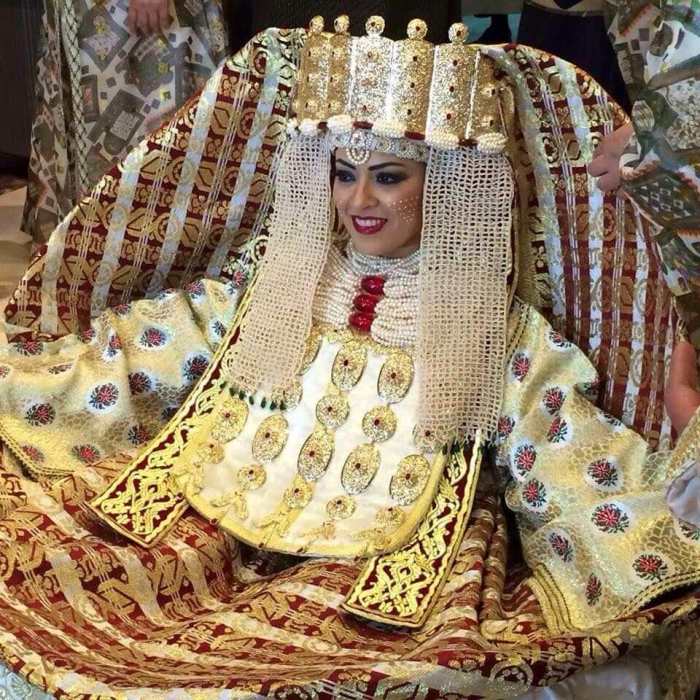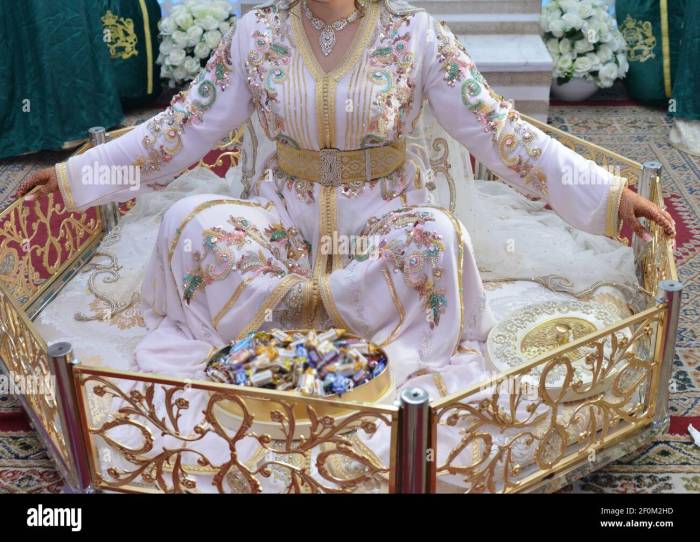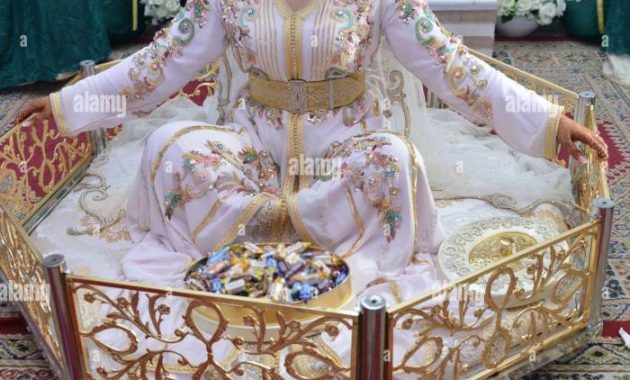Traditional Moroccan Wedding Dress Styles
Bride moroccan wedding dress – Moroccan wedding dresses, particularly the Kaftan, are renowned for their opulent designs and rich cultural symbolism. These garments are not merely clothing; they are a testament to the bride’s heritage, family status, and the joyous occasion of her marriage. The styles vary significantly across different regions, reflecting the diverse artistic traditions within Morocco.
Key Features of a Classic Moroccan Kaftan Wedding Dress
The classic Moroccan Kaftan wedding dress is characterized by its flowing silhouette, often featuring long, wide sleeves and a graceful, floor-length design. Intricate embroidery and embellishments are key elements, frequently adorning the neckline, sleeves, and hem. The fabric itself is usually luxurious, contributing to the overall sense of opulence. A common feature is a deep V-neckline or a high, closed neckline, depending on regional customs and personal preference.
The Kaftan often incorporates a belt or sash to cinch the waist, highlighting the bride’s figure.
Regional Variations in Embroidery and Embellishments, Bride moroccan wedding dress
Embroidery styles and embellishments vary widely across Morocco’s diverse regions. The Fes region, known for its sophisticated craftsmanship, often features intricate needlework with metallic threads, creating dazzling patterns. In Marrakech, you might find bolder, more vibrant embroidery, reflecting the city’s energetic atmosphere. Coastal regions might incorporate elements inspired by the sea, while southern regions may show influences from Berber traditions.
These variations showcase the rich tapestry of Moroccan artistry.
Comparison of Fabrics Used in Traditional Bridal Attire
Silk, velvet, and brocade are popular fabrics for Moroccan wedding dresses, each offering a unique texture and aesthetic. Silk provides a luxurious drape and a subtle sheen, often used for lighter, more flowing designs. Velvet adds a rich, opulent feel, ideal for winter weddings or more formal occasions. Brocade, with its intricate woven patterns, provides a visually striking and textured surface, often incorporated into more elaborate designs.
Regional Variations in Moroccan Bridal Dress Styles
| Region | Fabric | Embellishment | Silhouette |
|---|---|---|---|
| Fes | Silk, Brocade | Intricate metallic thread embroidery | Flowing, A-line |
| Marrakech | Velvet, Silk | Bold, colorful embroidery | Fitted bodice, flared skirt |
| Southern Morocco | Heavy brocade, embellished fabrics | Geometric patterns, Berber motifs | Long, loose fitting |
| Coastal Regions | Lighter silks, cotton blends | Seashell motifs, lighter embroidery | Flowing, often with open sleeves |
Modern Interpretations of the Moroccan Wedding Dress
Contemporary designers are creatively reinterpreting traditional Moroccan wedding dress elements, blending classic aesthetics with modern silhouettes and innovative design techniques. This results in breathtaking gowns that honor tradition while embracing contemporary fashion trends.
Modern Designers’ Reinterpretations of Traditional Elements
Modern Moroccan wedding dresses often retain the rich embroidery and embellishments of traditional Kaftans, but incorporate them into more streamlined silhouettes. A-line gowns, sheath dresses, and even modern ballgowns are now adorned with traditional Moroccan motifs, creating a unique fusion of styles. Designers are experimenting with new fabrics and techniques, while still maintaining the essence of the traditional garments.
Examples of Contemporary Moroccan Bridal Gowns
Imagine a contemporary Moroccan wedding dress: a flowing A-line gown crafted from luxurious ivory silk, subtly embroidered with delicate silver threads depicting traditional Moroccan floral patterns. The neckline is a modern V-neck, but the sleeves are long and wide, echoing the traditional Kaftan. Or perhaps a sleek sheath dress in deep emerald green velvet, adorned with intricate gold embroidery around the neckline and hem.
These designs showcase the successful integration of modern and traditional aesthetics.
Influence of Western Fashion Trends
Western fashion trends, particularly in terms of silhouette and fabric choices, have influenced the design of modern Moroccan wedding dresses. However, the incorporation of these trends is carefully balanced with the preservation of traditional Moroccan design elements, ensuring that the cultural heritage remains central to the design.
Visual Description of a Modern Moroccan Wedding Dress
Envision a modern Moroccan wedding dress in a blush pink silk, featuring a fitted bodice that flows into a full, A-line skirt. Delicate gold embroidery, depicting traditional henna patterns, adorns the neckline and sleeves. The back features a low, elegant neckline, while the front maintains a more modest, high neckline. The overall effect is one of effortless elegance, seamlessly blending traditional Moroccan artistry with contemporary sophistication.
The Significance of Color and Symbolism: Bride Moroccan Wedding Dress
Color and symbolism play a crucial role in Moroccan wedding attire, carrying deep cultural significance and reflecting the bride’s status and family heritage. Specific colors and patterns are chosen not merely for aesthetic appeal but also to convey powerful messages.
Cultural Significance of Specific Colors
Red is a dominant color in Moroccan weddings, symbolizing joy, fertility, and good fortune. Gold represents wealth, prosperity, and royalty. Green, associated with Islam, signifies hope, peace, and abundance. The choice of colors often reflects the bride’s family’s social standing and the region she comes from.
Symbolism of Embroidery Patterns and Motifs
The intricate embroidery patterns and motifs found on Moroccan wedding dresses often tell stories. Floral patterns symbolize beauty and abundance, while geometric designs can represent strength and protection. Specific motifs, such as henna patterns or Berber symbols, carry deeper cultural meanings, reflecting the bride’s family lineage and regional identity.
Colors and Symbols Reflecting the Bride’s Status and Heritage
The richness of the fabrics, the intricacy of the embroidery, and the choice of colors all contribute to conveying the bride’s status and family heritage. A bride from a wealthy family might wear a dress made of luxurious velvet or brocade, heavily embellished with gold embroidery, while a bride from a more modest background might wear a simpler dress, but still with significant cultural symbolism in its design.
Symbolic Meaning of a Common Color or Motif
The color red, frequently found in Moroccan wedding dresses, embodies joy, passion, and fertility. It is a powerful symbol of celebration and signifies the beginning of a new, vibrant chapter in the bride’s life. The intensity of the red shade, and its combination with other colors, can further convey nuances of meaning and reflect regional variations.
Accessories and Jewelry in a Moroccan Wedding
Traditional Moroccan wedding attire is complemented by an array of exquisite jewelry and accessories, each holding cultural significance and contributing to the overall splendor of the bride’s appearance. These pieces are often family heirlooms, passed down through generations.
Traditional Jewelry Pieces Worn by Moroccan Brides
Moroccan brides typically adorn themselves with a variety of jewelry pieces, including elaborate necklaces, bracelets, earrings, and rings. These pieces are often made of gold, silver, or a combination of both, and frequently feature intricate designs, gemstones, and traditional motifs.
Materials and Craftsmanship in Jewelry Creation
The craftsmanship involved in creating these jewelry pieces is often exceptional, reflecting the high level of artistry found in Morocco. Traditional techniques are employed, utilizing high-quality materials and meticulous attention to detail. Many pieces are handcrafted by skilled artisans, ensuring their unique character and lasting value.
Comparison of Jewelry Styles from Different Regions

Source: moroccoworldnews.com
Similar to the variation in dress styles, jewelry styles also differ across Morocco’s regions. Southern regions might feature heavier, more ornate pieces, reflecting Berber traditions, while coastal regions may incorporate lighter, more delicate designs, inspired by the sea. These regional variations add to the richness and diversity of Moroccan bridal jewelry.
Essential Accessories and Their Significance

Source: alamy.com
- Elaborate Necklace: Symbolizes wealth and status.
- Bracelets and Rings: Represent good fortune and blessings.
- Earrings: Often feature traditional motifs and reflect regional styles.
- Headpiece/Crown: Adds to the bride’s regal appearance and symbolizes her new status.
- Veil: Traditionally signifies modesty and purity.
The Role of the Wedding Dress in the Ceremony
The wedding dress plays a central role in the Moroccan wedding celebration, symbolizing the bride’s transition into marriage and serving as a focal point throughout the various stages of the ceremony. It is more than just attire; it’s a powerful visual representation of her journey.
Importance of the Wedding Dress in the Moroccan Wedding Celebration
The wedding dress is a crucial element in the overall celebration, not just for its aesthetic appeal but also for its symbolic weight. It reflects the bride’s family’s heritage, her social standing, and her transition into married life. The dress is often a source of pride and joy for the bride and her family.
Stages of the Ceremony Where the Dress Plays a Significant Role
The dress is central to various stages of the ceremony, from the pre-wedding henna ceremony to the wedding feast and beyond. The intricate details of the dress are admired by guests, and it serves as a visual centerpiece throughout the celebration.
The Dress Reflecting the Bride’s Journey into Marriage
The wedding dress symbolizes the bride’s journey into a new chapter of her life. The opulence of the dress, the intricate details, and the cultural significance of the design all contribute to the emotional weight and symbolism of the garment. It is a powerful visual representation of this significant transition.
Narrative Describing a Bride’s Experience
Aisha, radiant in her crimson velvet Kaftan, felt the weight of tradition and the excitement of the future. The intricate gold embroidery, a family heirloom, shimmered as she moved, a testament to generations of brides before her. As she greeted guests, the rich fabric swirled around her, a visual representation of her journey into marriage. The deep red color, a symbol of joy and prosperity, seemed to radiate from her, mirroring the happiness in her heart.
FAQ Insights
What are some common fabrics used in Moroccan wedding dresses?
Silk, velvet, brocade, and other luxurious fabrics are frequently used, often depending on the region and the bride’s preference.
How long does it typically take to create a traditional Moroccan wedding dress?
The creation process can take several months, even years, depending on the intricacy of the embroidery and embellishments.
Moroccan wedding dresses often showcase intricate embroidery and luxurious fabrics, reflecting the rich cultural heritage. For a fairytale-inspired twist, brides might draw inspiration from the elegance of a beauty and the beast dress wedding , adapting the romantic silhouette to complement traditional Moroccan design elements. Ultimately, the bride’s choice reflects her personal style, blending tradition with individual flair.
Are there specific hairstyles traditionally associated with Moroccan brides?
Yes, elaborate braids, updos adorned with flowers or jewelry, and other styles reflecting regional traditions are common.
What is the significance of the veil in a Moroccan wedding?
The veil symbolizes modesty, purity, and the transition into married life. Its style and embellishments can vary regionally.

